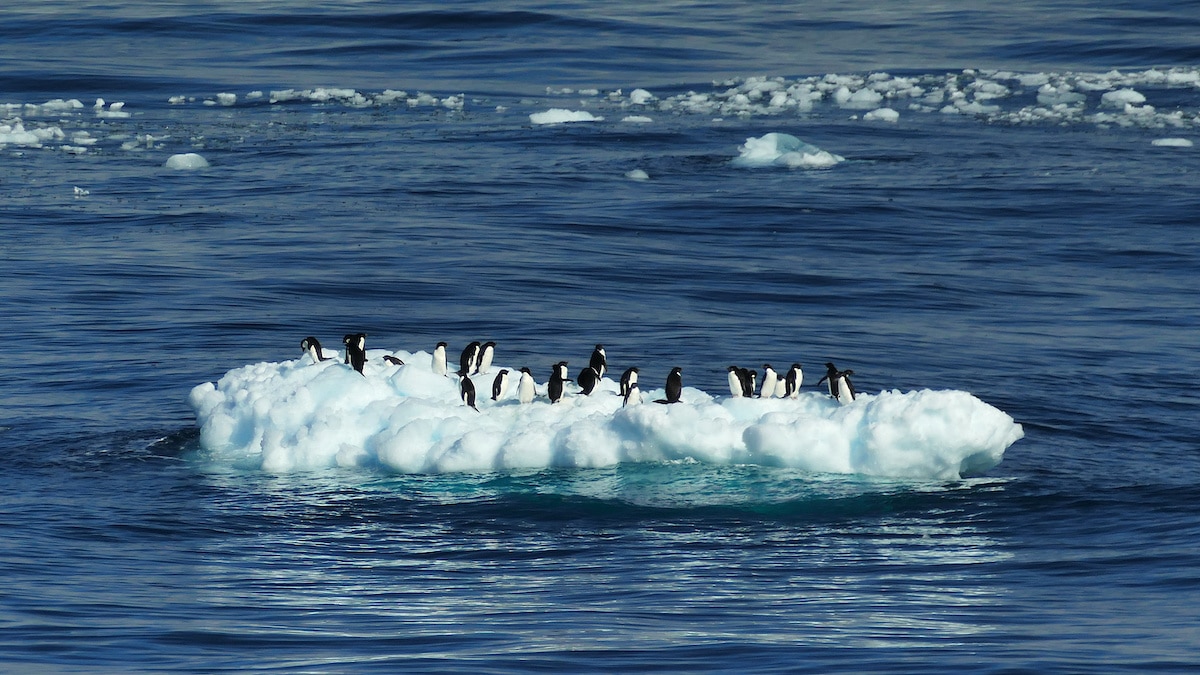
Greenland and Antarctica Already Melting at ‘Worst-Case-Scenario’ Rates

Penguins gather on an ice floe near Davis Station, Southern Ocean, Antarctica on Jan. 25, 2019. copyright Jeff Miller / Moment / Getty Images
Antarctica and Greenland‘s ice sheets are currently melting at a pace consistent with worst-case-scenario predictions for sea level rise, with serious consequences for coastal communities and the reliability of climate models.
A paper published in Nature Climate Change Monday compared the latest satellite observations of polar ice melt with the predictions outlined in the Intergovernmental Panel on Climate Change (IPCC) Fifth Assessment Report. It found that the ice sheets are currently raising sea levels at a rate 45 percent above the IPCC’s central prediction and closer to its worst-case scenario. If this continues, the two ice sheets could raise sea levels a further 17 centimeters (approximately 7 inches) more than central predictions by 2100.
“If ice sheet losses continue to track our worst-case climate warming scenarios we should expect an additional 17cm of sea level rise from the ice sheets alone,” study coauthor and University of Leeds researcher Anna Hogg said in a university press release. “That’s enough to double the frequency of storm-surge flooding in many of the world’s largest coastal cities.”
Ice sheets losses are tracking the IPCCs worst case climate predictions. This could mean an extra 17 cm of sea level rise by the end of the century from Antarctica and Greenland alone!
Article led by Dr Tom Slater (CPOM) released in Nature today: https://t.co/TujPw2HWxU pic.twitter.com/sN9Fgpe22w
— CPOM News (@CPOM_news) August 31, 2020
Since the 1990s, the two ice sheets have already increased global sea levels by 1.8 centimeters (approximately 0.7 inches). But it was between 2007 and 2017 that the ice sheets began to lose mass at a rate consistent with worst-case-scenario projections, adding around 1.23 centimeters (approximately 0.5 inches) to the water line during that decade, according to the study.
A worst-case-scenario sea level rise as currently predicted would expose 44 to 66 million people to yearly coastal flooding by century’s end. But one of study’s most alarming implications is that, if sea level rise is already tracking worst-case-scenario predictions, the actual worst-case scenario could be even more dire.
“We need to come up with a new worst-case scenario for the ice sheets because they are already melting at a rate in line with our current one,” lead author and Centre for Polar Observation and Modelling (CPOM) at the University of Leeds researcher Thomas Slater told AFP. “Sea level projections are critical in helping governments plan climate policy, mitigation and adaptation strategies. If we underestimate future sea level rise, then these measures may be inadequate and leave coastal communities vulnerable.”
One of the reasons climate models might underestimate the worst-case scenario, Slater told AFP, is that they do not account for short-term weather changes such as the heat wave that drove Greenland’s record melt in the summer of 2019.
The models that will be used for the IPCC’s next report are better at predicting how the ice sheets, oceans and atmosphere interact, Slater said.
The latest study follows a slew of bad news for the world’s ice. One study published in August found that the Greenland ice sheet had passed the “point of no return” and would continue to melt even if the climate crisis were halted.
Another recent study, also driven by Leeds’ CPOM, calculated that the earth had lost 28 trillion tonnes (approximately 31 trillion U.S. tons) of ice in just 23 years.
These studies reflect a new global reality: In the last five years, melt from ice sheets and glaciers has outpaced the expansion of warming ocean water as the main cause of sea level rise.
“It is not only Antarctica and Greenland that are causing the water to rise,” Dr. Ruth Mottram, a coauthor on Monday’s study and a climate researcher at the Danish Meteorological Institute, told the University of Leeds. “In recent years, thousands of smaller glaciers have begun to melt or disappear altogether, as we saw with the glacier Ok in Iceland, which was declared ‘dead’ in 2014. This means that melting of ice has now taken over as the main contributor of sea level rise.”
- Antarctica and Greenland Raised Sea Levels More Than Half an ...
- Polar Ice Caps Melting Six Times Faster Than in the 1990s - EcoWatch
- Greenland Lost 600 Billion Tons of Ice Last Summer, Raising Sea ...
- Greenland's Ice Sheet Is Melting at Rate That Surpasses Scientists ...
- Greenland Ice Sheet Melting Faster Than at Any Time in Last 12,000 Years, Study Finds - EcoWatch
- Earth's Ice Loss Reflects Worst-Case Scenario, New Study Finds - EcoWatch
- 'We Need to Act Now': Glaciers Melting at Unprecedented Pace, Study Reveals
- Arctic Warming 3x Faster Than Earth's Average Rate, Study Finds

 233k
233k  41k
41k  Subscribe
Subscribe 